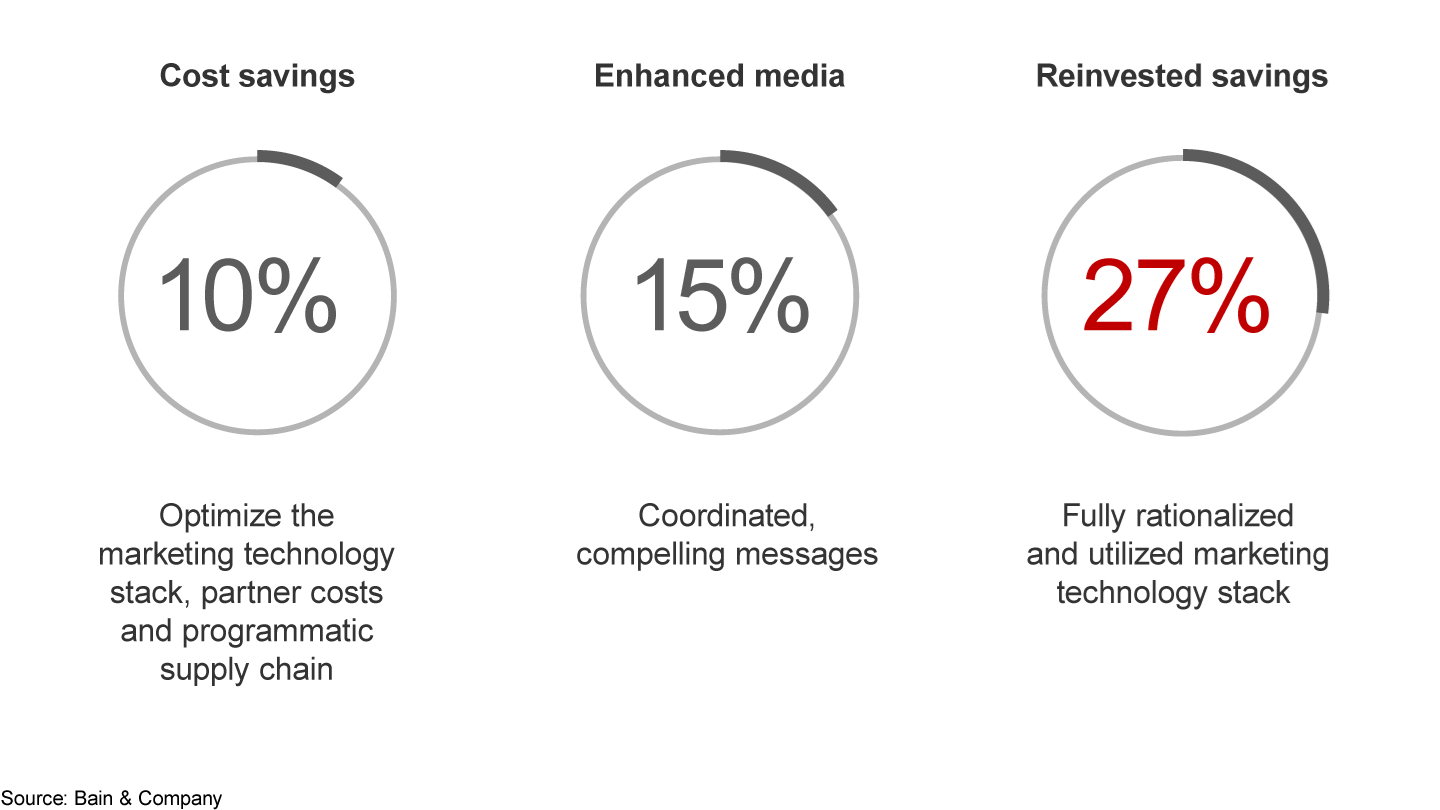Etude

En Bref
- Marketing technologies often accrete haphazardly over time, leaving CMOs with a tangle of duplication.
- We estimate that optimizing the use of marketing technology typically improves the marketing budget’s return on investment by up to 27%.
- Leading marketing organizations address three areas: wasting less money, increasing return on advertising spending, and leveraging technology and data to create new revenue streams.
- Effective technology integrates well with data and relies on strong governance and people with the right skills to steer it.
Marketing technology has suddenly become both more important and more problematic. With the surge of online search and shopping in response to Covid-19-induced lockdowns, many companies expect their chief marketing officers (CMOs) to ramp up digital customer acquisition, yet also contain or cut spending on technology, media and staff.
The challenge in accomplishing these goals nearly always involves taming the sprawling marketing technology zoo that CMOs preside over. Each software choice is typically procured and licensed or built at a brand, market or divisional level. There is little governance over selection or integration with other systems in the organization. As a result, marketing groups often suffer from duplication of technical functions.
One technology retailer, for instance, had 13 email marketing technologies in one office location, each procured by different people, funded from different budgets, used by different teams. Needless to say, technology duplication made integration of data problematic. Each system functioned at a fraction of its potential, with messages to audiences either duplicated or disjointed.
Other parts of the marketing organization may have significant gaps in the technologies they need, such as making sure their display ads are actually viewable on approved publisher websites, bringing together a single view of a customer or having near-real-time access to marketing performance data tailored to specific roles within the organization. Given the ascendance of digital channels, combined with heightened competition from digital insurgents in most markets, optimizing the choices and use of marketing technology has become critical for reining in costs while increasing customer value during the pandemic.
Indeed, for many companies in consumer markets, Bain & Company estimates that optimizing their use of marketing technology typically improves the marketing budget’s return on investment (ROI) by up to 27% (see Figure 1). A global retailer, for instance, merged in-store purchase data with online browsing and purchase data to better understand consumer behavior. By incorporating this data into the marketing optimization process, the retailer boosted sales significantly.
Effective marketing technology can boost the return on marketing budgets as much as 27%


As CMOs and other marketing executives consider how to tame the profusion of technology and harness it to work more effectively, they can tackle the problem by answering high-gain questions in three areas.
Wasting less money
-
- Are we spending on multiple systems that do the same job?
- Are we spending on agencies or partners for work that could easily be automated, such as producing performance reports?
- Are we duplicating work across teams and markets, such as creating new product images and videos that have already been created by other teams, but weren’t stored in a central system?
Increasing return on advertising spending
-
- How can we use our data on customers to better target them at the right time, in the right place and with the right message?
- Do we understand how our advertising performs, so that we can optimize campaigns in real time?
Leveraging technology and data to create new revenue streams
- How can we use data that we gather within the business to create new engines for growth?
- How can we create new digital propositions for customers through new digital channels?
- How can we leverage our digital properties to create additional revenue opportunities through advertising, cross-selling or upselling?
Useful answers to these questions involve not just technology, but also a skilled staff deployed in processes that use the technology effectively to create a powerful experience for customers. It’s easy to forget the role of people and processes. One manufacturing company, for example, rarely used its customer data platform to inform media campaigns, because there was no process in place to personalize the experience and raise engagement. Likewise, marketers at a consumer goods company believed their data management platform wasn’t working, when in reality the company lacked people who knew how to put the platform to good use.
Technology works best when it has the following characteristics:
- functionality to deliver a great customer experience;
- integrated with data flowing throughout the system;
- strong governance that meets the process, legal and privacy requirements;
- measurement of advertising performance, including the efficiency of delivering ads; and
- the ability to anticipate future shifts, such as Google’s announcement that it will phase out third-party cookies in 2022, and Apple’s announcement to eliminate its Identifier for Advertisers tracking on iOS 14 and beyond. Advertisers will need to adapt their technology to measure, optimize and retarget consumer journeys in a cookie-less world.
Technology remains the foundation of digital transformation to reduce costs, improve ROI and tap new growth opportunities. But to make real strides, technology needs skilled people to steer it and the right processes to make it effective.